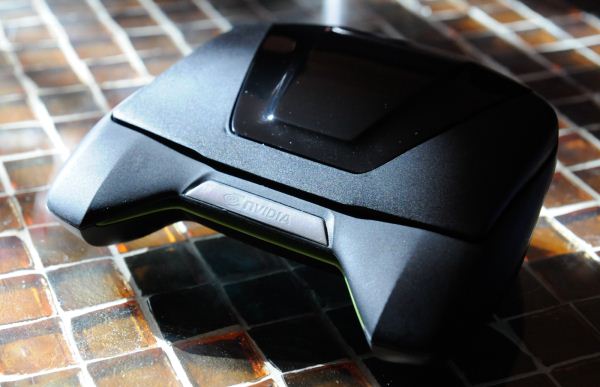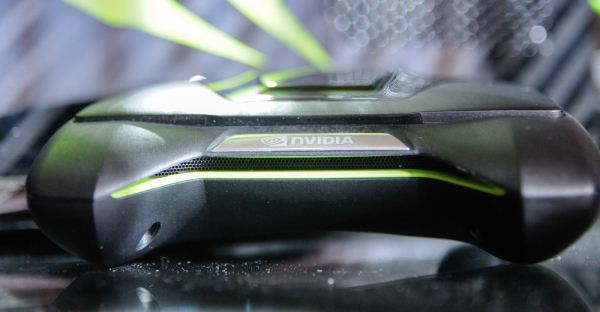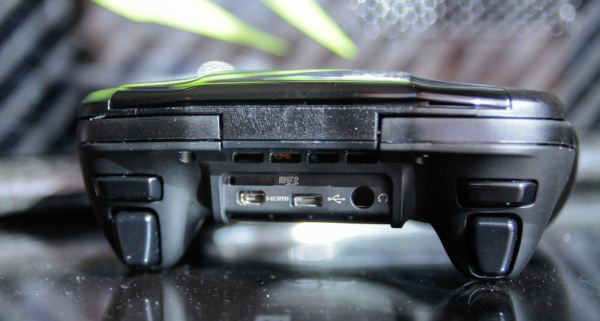Hands on With NVIDIA's Project Shield - Update: Now With Video
by Brian Klug on January 7, 2013 5:11 PM EST- Posted in
- Trade Shows
- CES 2013
- Shield
- Tegra 4
- NVIDIA
Anand and I just spent some time playing with NVIDIA's recently announced Project Shield, which is NVIDIA's portable handheld gaming device home to the also just-announced Tegra 4 SoC (4x ARM Cortex A15). I came away pretty impressed with Project Shield ergonomics after initially going in very skeptical (like GPU editor Ryan Smith) about how 38 watt-hours of batteries, a display, Tegra 4, and all the accompanying hardware could possibly feel comfortable stuffed into what boils down to a game controller.
First off, Shield isn't nearly as heavy as I thought it would feel in the hands. I expected Shield to feel very dense, instead the device doesn't feel much different from a wireless Xbox 360 controller with the rechargeable battery pack. I made a point of holding onto the Shield the entire time in a few different positions and didn't feel my hands or arms fatiguing at all. NVIDIA carefully positioned the batteries right around the palm areas, so the heaviest parts of the device are right in-axis with ones palms and arms rather than being elsewhere that would torque one's grip. There's something about the construction that feels balanced and masks the fact that this is actually a sizeable piece of hardware. Shield will have a soft touch bottom and different top texture finish, this first version we played with did not.
NVIDIA was eager to point out that both the D-Pad, triggers, and bumpers are all in the process of being tweaked and tuned, and that the spring preloads and click points on the Shields we played with were nowhere near final. This is good to hear as the D-Pad at present definitely needed to be less mushy and more communicative, we're told this will be replaced with a much more responsive one before Shield is finalized. I didn't have a problem with the analog sticks but would love to feel alignment nubs or texture on the domes.
My biggest thoughts were framed around the placement of the two analog sticks, which at present is places the tops of them in the plane of the buttons and D-Pad. This initially felt very alien, until I realized this is done because the display needs to close shut (the analog sticks would otherwise protrude through the screen) but felt a little bit awkward. I'm used to the 360 controller personally, which has analog sticks that protrude above the plane of the buttons. I can see one getting used to this as it feeling awkward is simply an artifact of my prior exposure and trained response to the 360 controller.
The 720p 5-inch "retinal" display indeed exceeded my visual acuity and was hard to pick out individual pixels on, though I still think there's too much bezel on Shield that should be taken up with more display. Something like a 5.5" 1080p display would make much more sense, but that's probably reserved for another iteration. The biggest concern is how smaller features on PC games played back on the Shield would be difficult to pick out. NVIDIA claims it will mitigate this by working with game developers on appropriate titles or offering a pinch to zoom feature to let users read small elements. Obviously some games with lots of text (they offered the example of EVE Online) can't possibly work perfectly, but I had no problems playing a few levels of Assassins Creed 3 and Black Ops 2 on Shield. I could see some H.264 artifacts while playing on Shield, higher bitrates could solve that problem easily.
Wireless connectivity on the Shield is courtesy Broadcom's latest BCM43241 which is 2x2:2 802.11a/b/g/n, which is the right thing to do in a platform that so strongly leverages wireless display and control. Responsivity while playing PC games on the Shield was extremely good, I couldn't detect any lag.
At the front of the Shield is a small gap and grille, it turns out that heatsink in the NVIDIA press event video was in fact real, as air is drawn from the front of the Shield, over the heatsink, and exhausted out the back. There is indeed a fan inside, albeit a small one. NVIDIA says it won't come on all the time during normal use, and after playing a few Android games natively (Hawken) on the device this seemed to be the case. One Shield left in the sun did have the fans kick on though, which are essentially inaudible. I didn't actually feel Shield get hot at all during use, but that heatsink wasn't just for show in the press event video/demo, it's real.
At the very back are the microSD, microHDMI, microUSB, and headphone jack. I'm told these are also changing slightly and would honestly like to see the headphone jack come around to the front.
What really struck me about the Shield was how very far from ergonomic the device appears, and yet how surprisingly comfortable it is to hold. NVIDIA nailed the underside ergonomics almost perfectly, there's a small ledge for your fingers to rest on, and the palm cups are indeed reminiscent of the 360 controller.
Android 4.2.1 on the Shield felt extremely responsive and fluid. I am very impressed with browser scrolling in both Chrome and Browser.apk, the latter of which is now a huge optimization target for NVIDIA. The rest of the UI was also very fluid. I should note that NVIDIA is not allowing benchmarking at present, so we can't say anything but just subjective impressions about Tegra 4 performance.
We recorded a video of gameplay on the Shield and are uploading it as fast as CES connectivity will afford. Edit: Videos are now up.



















41 Comments
View All Comments
Stuka87 - Monday, January 7, 2013 - link
So... what is the point of this?You need to be on Wifi with your PC in order to stream, which means you are at home. So why should I give up my big monitor, keyboard and mouse to play on a small screen with a console controller that apparently gets hot enough to need a fan?
Oh, and what on earth is a "Retinal" display? 720P on a 5" screen isn't enough to be a retina, so they call it a retinal? If that is not meant to confuse consumers, not sure what is.
guidryp - Monday, January 7, 2013 - link
I assume "Retinal" is avoiding Apples "Retina" trademark.BenSkywalker - Monday, January 7, 2013 - link
The display is 293.72ppi- the latest "retina" iPad is lower then that.jamdev12 - Monday, January 7, 2013 - link
Stuka87,Unless you watched the show yesterday, the main attraction wasn't that you could stream content (games) from your PC to the 5" screen, it was the fact that you could stream that content to your TV through this controller. So instead of using your 24" screen to play your game, you can play it on your 60" HDTV without wires.
Stuka87 - Monday, January 7, 2013 - link
Now, I did not watch it, although watching the video that is posted above (now) gives a better idea of the device. And it does look cool.I assume your TV would either have to support wireless streaming, or there is a device that plugs into an HDMI port or the like?
tipoo - Tuesday, January 8, 2013 - link
Toilet gaming.mckirkus - Monday, January 7, 2013 - link
I hope they wrapped this thing in 98.6 degree gel during thermal testing. It's not often you see a computing device designed to be death gripped by potentially chubby man hands.zebrax2 - Monday, January 7, 2013 - link
I would assume it would be on the same room as the router if so then how was the performance as you slowly back away from the routerJNo - Monday, January 7, 2013 - link
Despite all the knowledge and experience and expertise, I sometimes wonder at the expectations made by you guys at anandtech.You wonder why they didn't do 5.5" at 1080p? Really? When 720p at 5" is already retina so any more pixels would be indistinguishable? And when you're already noticing bandwidth constrained artifacts at 720p? (which of course you're still going to get at 1080p)
And then there's cost (I presume they want to sell some!!), power consumption, battery life, frame rates of native android games, the fact that there are no natural competitors in this niche to worry about out-spec'ing etc etc.
I'm not trying to be rude but 1080p would be really really dumb for nvidia for this device.
This Guy - Monday, January 7, 2013 - link
One benefit of running at 720p include larger text and UI items.Another benefit is that any game will run on ultra settings and 4x AA at 60 fps.
Artifacts may be less visible at 1080p (even if there are more artifacts) as there would be around twice as many pixels in the same area. They could also pair it with an AC router or USB3 stick if bandwidth was a problem.